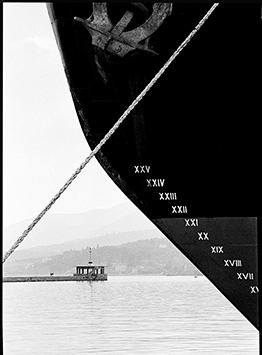http://www.quarterly-review.org/?tag=dimitris-yeros
Posted on March 25, 2013 by Derek Turner
=============================
“Harbours hitherto unseen” –
the charm of Constantine Cavafy
DEMETRIS DEMOPOULOS reviews a lavish tribute to the great Greek poet
Shades of Love: Photographs Inspired by the Poems of C. P. Cavafy
Dimitris Yeros, Insight Editions, Athens, 2012, hardback, 168pps., 60 Euros
- P. Cavafy is widely considered the most distinguished Greek poet of the twentieth century. He was born in 1863 in Alexandria, Egypt, where his Greek parents had settled in the mid-1850s. He lived in England (in Liverpool, where his family had business ties) for much of his adolescence, and developed both a command of the English language and a preference for the writings of Shakespeare and Wilde. During his lifetime Cavafy was an obscure poet, living in seclusion and publishing very little. A short collection of his poetry was privately printed in the early 1900s and reprinted with new verse a few years later, but that was the extent of his published poetry. Instead, Cavafy chose to circulate his verse among friends.
Many of his poems are highly personal, and he also wrote many explicitly erotic poems. His work is both a glorification of the human body and its pleasures, and elegiac of love and death. Cavafy was also an avid student of history, particularly of the Hellenistic age, and so in his poems there is a plethora of references to events from this period. His language and his manner were his own inventions, reflecting both his temperament and his vast knowledge of the ancient civilisation.
For those who are unfamiliar with his oeuvre, it might be useful to give examples of two of his best-known poems, starting with “Ithaca” (all poems translated by David Connolly):
As you set out for Ithaca,
Hope that the journey is a long one,
Full of adventures, full of learning.
Of the Laestrygonians and Cyclopes,
Of wrathful Poseidon have no fear,
You’ll never meet such like on your journey,
If your thoughts remain lofty, if noble sentiments
Grip your body and spirit. You’ll never encounter raging Poseidon,
Laestrygonians and Cyclopes, unless you bear them in your soul,
Unless your soul sets them before you.
Hope that the journey is a long one.
That the summer morns be many when with what delight, what joy
You enter harbours hitherto unseen; that you stop in the Phoenician markets
And acquire fine merchandise, nacre and coral, amber and ebony,
And all kinds of heady perfumes as you can; that you visit many Egyptian cities,
To learn and learn from the erudite.
Always keep Ithaca in mind.
To arrive there is your destination.
But in no way rush the voyage. Better for it to last many years; and for you
To berth on the isle an old man, rich with all you gained on the journey,
Without expecting Ithaca to give you riches. Ithaca gave you the wonderful
Voyage. Without her you would not have begun the journey. Yet she has nothing more to give you.
“And though you may find her wanting, Ithaca has not deceived you.
Wise as you’ve become, with such experience, you’ll have already understood what these Ithacas mean.
Another perennial favourite is “Thermopylae”:
Honour to those who in their lives resolved to defend some Thermopylae.
Never wavering from duty; just and forthright in all their deeds,
But with pity and compassion too; generous whenever rich, and when
Poor, still generous in smaller ways, still helping all they can; always speaking the truth, yet without hatred for those who lie.
And still more honour is their due, when they foresee (and many do foresee)
That Ephialtes will eventually appear, and the Medes will, in the end, get through.
Dimitris Yeros is a renowned painter and innovative artist. His photographs have been shown in many exhibitions in Greece and abroad, mainly in the USA. In his latest book, he presents selected Cavafy poems that have been elegantly Englished by David Connolly of the Aristotle University of Thessaloniki, paired with an image that complements that poem. There are nearly seventy photographic illustrations using a mixture of models and fellow members of the artistic community. The overall effect is one of great visual richness.
Edward Albee, one of the most important contemporary American dramatists (best known for Who’s Afraid of Virginia Woolf?, The Zoo Story, The Sandbox, and The American Dream) has written the foreword and the introduction is by American poet and arts reviewer John Wood. Albee writes:
I remember I began reading Cavafy when I was quite young – when all the juices which sprang from his poetry were within me as well. I read him in translation, of course, and, first, in imperfect readings; then as the equivalencies improved, in better versions of the original. In whatever readings, I found his poetry so vivid, so personal, so beautiful, so powerful that I was aware of being in the presence of a great poet, one whose concerns echoed mine and whose mastery was thrilling.
Most of the poems are enhanced with photographs of nude handsome young men where they play with the theme of desire and memory. Homoeroticism, intrigue, humour, hedonism and despair are everywhere in the book. However, among Yeros’s models are prominent members of the artistic community such as Jeff Koons, Gabriel Garcia Marquez, Gore Vidal, Tom Wesselmann and Clive Barker, Olympia Dukakis, Carlos Fuentes and Naquib Mahfuz. These notable names come from Yeros’s idea to use “people from the world of letters and the arts…who knew and admired Cavafy’s poetry”.
The translated poems are each set at the centre of a huge white page and accompanied by full page illustrations. David Connolly has made worthy efforts to translate in a way that is both distinctive and artistic. Cavafy’s use of the Greek language was rather bizarre and he has a reputation of being difficult to translate.

Inside the book there are many fine combinations of poems and photos. On page 60 is “The souls of old men” –
In their aged, wasted bodies dwell the souls of old men.
How pitiful the poor things are and how weary of the wretched life they lead.
How they tremble lest they lose it and how they cherish it
These confounded and contradictory souls – so tragicomical – that dwell
In their aged, ravaged hides.
The poem is accompanied by a characteristic photo of five old men at Pamfila (Lesbos Island) full of wrinkles, staring compassionately into the lens.
In another example (p. 118), “Supplication” describes the prayer of a sailor’s mother to the Virgin Mary for the safe return of her son. However,
The sea took a sailor to its depths. –
Unaware, his mother goes and lights a long candle to the Holy Virgin
for his swift return and for fair weather – and always she has her ear
to the wind. But while she prays and supplicates, the icon listens grave and
sorrowful, knowing the son she awaits is not coming back.
To accompany the poem, Yeros has chosen the Oscar-winning actress Olympa Dukakis in typical Mediterranean costume, complete with black kerchief, holding a long candle while her face wears a sorrowful expression.
One of my favourite poems is “Che Fece…Il Gran Rifiuto” (“for some people there comes a day when they are obliged to say either Yes or No”).
For some people there comes a day
when they are obliged to say either Yes or No.
It is immediately clear who has the Yes ready within, and saying it goes
far beyond to honour and conviction.
Refusing, the other has no regrets. If asked again,
he would still say no. And yet he is beset by that no – the right one – throughout his life.
Cavafy has borrowed the phrase from Dante’s Divine Comedy. The precise phrase is “Colui Che fece per viltate il gran rifiuto” (“the refusal to life that is worthy of eternal damnation” – an allusion to Celestine who became Pope in 1294 and abdicated five months later, saying “the great No”). Dante sees this as an act of cowardice, but Cavafy sees it as honourable. Yeros has chosen an enigmatic illustration of the late Gore Vidal, one of the “Popes” of American literature, as accompaniment.
Cavafy himself divided his poetry into three thematic areas: historical, philosophical and sensual, with the hedonistic as a sub-category of the sensual. Although the sensual theme is dominant in Yeros’s book, the reader will find much value in the other two areas of Cavafy’s poetry, the historical and the philosophical. Perhaps we should consider this book as a first step into Cavafy’s mythical world. As he wrote in “First Step” in 1910:
Even though you stand on the first step, you still ought to be proud and happy. To have come so far is no small matter; to have done so much is great glory.
DEMETRIS DEMOPOULOS writes from Athens












